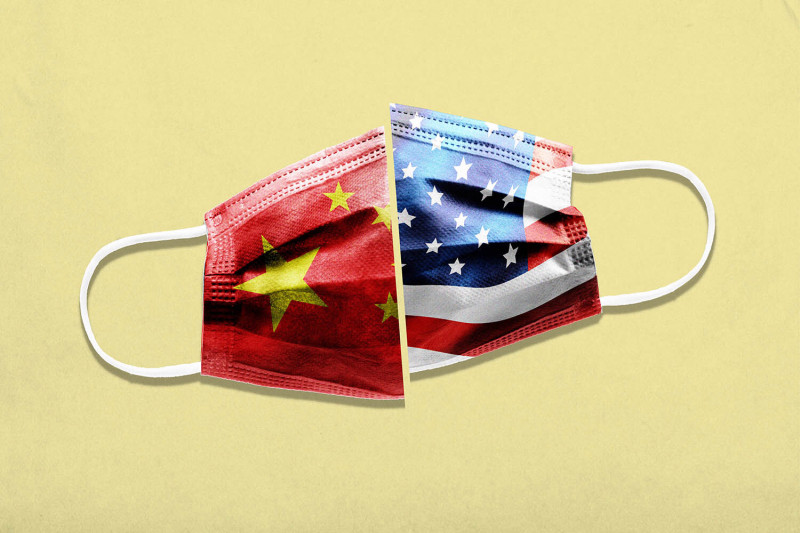
COVID-19 continues to wreak havoc around the world, not least in the United States. With the largest numbers of both confirmed infections and related deaths worldwide, the U.S. has suffered consecutive blows from the pandemic. Public indignation has surged in the U.S. in step with the pandemic, and calls for investigations and assignment of blame keep escalating. It’s sad that the world’s sole superpower is now in such an awkward situation.
As for blame, however, that depends on whether the COVID-19 infections the U.S. is suffering now have their roots in natural or man-made causes and on what governments at all levels in the U.S. have done thus far.
The U.S. intelligence community has indicated repeatedly that the novel coronavirus came from nature, not from genetic engineering. One appreciates the U.S. intelligence community’s honesty and courage in saying so. While the CIA made dramatic misjudgments about the source of the 9/11 terrorist attacks, the U.S. National Intelligence Council has typically withstood pressure from the White House — for example, in ascertaining whether or not Iran possessed nuclear weapons. This time, facing pressure from the Trump administration, the U.S. intelligence community again rendered an independent judgment, which truly deserves respect.
Since the novel coronavirus is from nature, it follos that only human error in coping with it lies behind its rampant spread in the U.S. Artificial factors fall in two categories: “external disaster” from the outside or “internal disaster” from within the U.S.
Let’s first consider the possibility of an external cause. Currently the U.S. side insists that China delayed its reporting and concealed the pandemic outbreak at home. Under this theory, that’s why China bears responsibility for the pandemic’s unprecedented spread. If that claim holds true, it may deflect some blame for the the inadequate response of U.S. leaders and officials.
It has already been shown that the Chinese government notified the U.S. 30 times in various ways from Jan. 3 to Feb. 3. Not once has the U.S. government denied this.
During an interview with China Central Television on Jan. 20, Chinese academician Zhong Nanshan, a world-leading virologist, said that the novel coronavirus was highly contagious. Beginning from Jan. 23, Wuhan and rest of Hubei province were locked down.
Judging from official information, people may have little idea specifically how the Chinese side informed the U.S. government from Jan. 3 to Jan. 20. If the U.S. doesn’t believe China about what it did during that period, it may have to wait for a neutral third-party investigation after the pandemic.
UN Secretary General Antonio Guterres has stated clearly that the UN would conduct an investigation into the origins of the novel coronavirus after the pandemic — theoretically including an investigation of all stakeholders including the U.S. Before that, the U.S. has the right to not trust the Chinese narrative, but not the right to force China and the rest of the world to accept its own version.
Even so, since Jan. 20 at least, the U.S. has no reason to believe that China concealed pandemic information. In the 54 days from Jan. 20 until March 13, the day the U.S. president announced a nationwide state of emergency, what was the U.S. doing? Although it suspended direct flights between China and the U.S. in early February, it didn’t immediately restrict other flights across the Pacific or Atlantic, seriously underestimating the risk of infection.
Governor Andrew Cuomo of New York later acknowledged that he had thought the novel coronavirus was only targeting Asians. People with such unscientific ideas were absolutely not just a small minority in the U.S. in the early days of the outbreak.
Then what was the U.S. federal government busy with? On Jan. 15, the U.S. House of Representatives formally submitted to the Senate two impeachment articles against President Donald Trump. On Feb. 5, the U.S. Senate voted to acquit Trump. During that period, the White House’s priority wasn’t preventing a pandemic. It was preoccupied with the survival of Trump’s presidency.
Afterward, Trump still placed the hope for overcoming the coronavirus on the possibility it would miraculously disappear in the spring. He said this on Feb. 27, and again on April 25.
If there were some problems on China’s part for its initial responses to the pandemic, such as under-reporting, misreporting or even possibly concealing the actual number of people infected, such acts certainly weren’t conducive to containing the pandemic as soon as possible. But these hypotheticals don’t compare with the magnitude of the U.S. side’s continuous inaction — and even mistaken actions — for more than two months after Jan. 20.
The New York Times on April 8 published an investigative report pointing out that Trump at first believed with blind confidence that he had cut off virus infections from China, and then failed to take seriously that the pandemic was already spreading from Europe in mid-February. The White House had repeatedly overlooked virus alerts from the U.S. intelligence community. And President Trump had time and again refused professional suggestions from his advisers about introducing social-distancing measures across the country. It’s clear, therefore, that the U.S. government had squandered 70 days as of April 8.
The present misery in the U.S. is basically the result of incompetent governance at the highest levels. It is misleading for the U.S. to substitute an external cause — China — for such a serious internal breakdown.
On the contrary, the U.S. has been fully notified since Jan. 20 at least, yet it has brought severe damage to itself and the rest of the world due to its own denials and mishandling, which is absolutely inexcusable. The U.S. is attempting to pass the buck after making such horrible trouble for its own people and failing in its responsibility as a major power.
